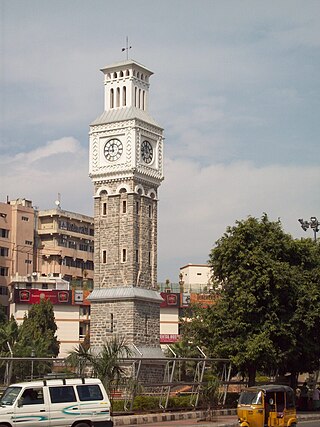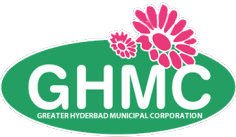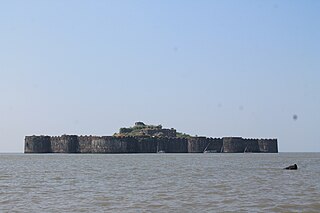
The Siddi, also known as the Sheedi, Sidi, or Siddhi, are an ethnic minority group inhabiting Pakistan and India. They are primarily descended from the Bantu peoples of the Zanj coast in Southeast Africa, most of whom came to the Indian subcontinent through the Indian Ocean slave trade. Others arrived as merchants, sailors, indentured servants, and mercenaries.

Secunderabad is a twin city of Hyderabad and one of the six zones of the Greater Hyderabad Municipal Corporation (GHMC) in the Indian state of Telangana. It is the headquarters of the South Central Railway zone. Named after the Mir Akbar Ali Khan Sikander Jah, Asaf Jah III, Nizam of the Asaf Jahi dynasty, Secunderabad was established in 1806 as a British cantonment. Although both the cities are together referred to as the twin cities, Hyderabad and Secunderabad have different histories and cultures, with Secunderabad having developed directly under British rule until 1948, and Hyderabad as the capital of the Nizams' princely state of Hyderabad. Since 1956, the city has housed the Rashtrapati Nilayam, the winter office of the president of India. It is also the headquarter of the 54th Infantry Division of the Indian Army.
The Chaush or Chaus are a community who are of Hadhrami Arab descent. They are found in the Deccan region of India.

Murud-Janjira is the local name of a famous fort and tourist spot situated on an island just off the coastal town of Murud, in the Raigad district of Maharashtra, India. Malik Ambar is credited with the construction of the Janjira Fort in the Murud Area of present-day Maharashtra India. After its construction in 1567 AD, the fort was key to the Sidis withstanding various invasion attempts by the Marathas, Mughals, and Portuguese to capture Janjira.

Hyderabadi Muslims, also referred to as Hyderabadis, are a community of Deccani people, from the area that used to be the princely state of Hyderabad in the regions of Marathwada, Telangana, and Kalyana-Karnataka.
Nacharam is a neighbourhood of Hyderabad in the Indian state of Telangana. It falls under Uppal Mandal. It forms Ward No. 6 of Greater Hyderabad Municipal Corporation.

Greater Hyderabad Municipal Corporation (GHMC) is the civic body that oversees Hyderabad, the capital and largest city of the Indian state of Telangana. It is the local government for the city of Hyderabad. It is one of the largest municipal corporations in India with a population of 7.9 million and an area of 650 km2.
Vidyanagar is a Locality of Hyderabad, Telangana, India. It formed Ward No. 86 of Greater Hyderabad Municipal Corporation.
Ramanthapur lies in the eastern part of the city of Hyderabad, located in the Indian state of Telangana. It lies between Uppal and Amberpet, on the road from Uppal to Kachiguda. The area has been drastically developed when compared to the early 1920s. The population has also sighted a raise with increase in construction of new residential buildings. It forms Ward No. 9 of Greater Hyderabad Municipal Corporation. Well Known Leader of Ramanthapur Gaddam Sai Kiran Educationalist Satyasai Group of Schools Chairman.
Qasim Yakut Khan also known as Yakut Shaikhji, Yakub Khan and Sidi Yaqub was a naval Admiral and administrator of Janjira Fort who first served under Bijapur Sultanate and later under the Mughal Empire.
Siddi Sambal was a Siddi naval officer who fought for the Mughal Empire. On 10 October 1673, he and his fleet entered Bombay without permission from the English East India Company (EIC) and attacked merchant shipping in the Pen and Nagothan rivers, disrupting the activities of both the EIC and Maratha king Shivaji.

The Old City of Hyderabad is a walled city of Hyderabad, Telangana, India, located on the banks of the Musi River built by Qutb Shahi sultan Muhammed Quli Qutb Shah in 1591 AD. There used to be a wall surrounding the Old City, most of which is destroyed. Mubariz Khan, the Mughal governor of Deccan Subah, had fortified the city in 1712 and was completed by Nizam of Hyderabad.
The Marfa is a form of celebratory rhythmic music and dance from Hyderabad, India, among the Hyderabadi Muslims, adapted from Afro-Arab music of Hadhramawt in Yemen. It is played at a high tempo using instruments such as marfa, daff, dhol, sticks, steel pots and wooden strips called thapi. The chorus effects and vocal meter are set according to beats.

The Hyderabad State Forces were the armed forces of the princely state of Hyderabad. People from both India and abroad were recruited into the Forces. Among these groups were Arab nationals like Chaush and African nationals like Siddis who now stay in Barkas and A. C. Guards areas of Hyderabad respectively. The Hyderabad cavalry was chiefly composed of Muslim castes such as Mughals, Pathans, Syeds, Sheikhs and Balochs. They were principally recruited from the Deccan, but Delhi, Lucknow, Shahjahanpur, Sindh and Balochistan also supplied recruits to bolster ranks. These non-indigenous soldiers were known as the "Rohollas". The Hindus made a very small portion of the cavalry. The Nizam of Hyderabad also had about 1200 Sikh guards. Other battalions within the army were referred to with the suffix "-walas". Some troops were also supplied by the Europeans for the security of the Nizam.

Janjira State was a princely state in India during the British Raj. It was governed by the Siddi Khan dynasty of Habesha descent and the state was under the suzerainty of the Bombay Presidency.

Elu Rottigalu is a thriller novel by the novelist, researcher, and scientist Dr K. N. Ganeshaiah. Elu Rottigalu means seven Kulchas or Rotis, the official emblem of the Nizams of Hyderabad. This novel is based on the history of Nizam of Hyderabad dynasty and narrated like cinema. Nizam, the ruler of Hyderabad plans to leave India, when India gets independence, along with the wealth, however because of Govt of India's control he could not do that. The novel is based on the story of this event and related things. This book has all the related references, list of witnesses and information required for the story lines. The novel also covers about Deendar Anjuman, Pakistan relationship with India, African Siddi and their migrations, and King Kothi Palace.
The localities and neighborhoods of Hyderabad have unique oral histories, dating to the time of the Qutb Shahi dynasty, over 400 years ago, and are named after various people and things. Some are named after a major building or structure in the locality, others named for individuals. The names are mostly in Telugu and Urdu, the major languages of the city. This is a list of localities, neighborhoods and streets of Hyderabad and their etymology.

The Raja Ram Rao Patil or Itbarrao Koli was an Admiral of the Ahmadnagar Navy and Koli ruler of Janjira. Patil built and fortified the Janjira Island.

The siege of Janjira was a military campaign undertaken by the Maratha Confederacy, commanded by Sambhaji, the second Maratha ruler, against the Siddis of Janjira in January 1682. The Maratha forces, led by Sambhaji, withdrew from Janjira to the Konkan region in response to Mughal attacks, leaving a contingent behind under the command of Dadaji Raghunath Deshpande. Despite their efforts, the Marathas were unable to capture the fort, and the Siddis pursued the retreating forces, plundering Maratha territories.












